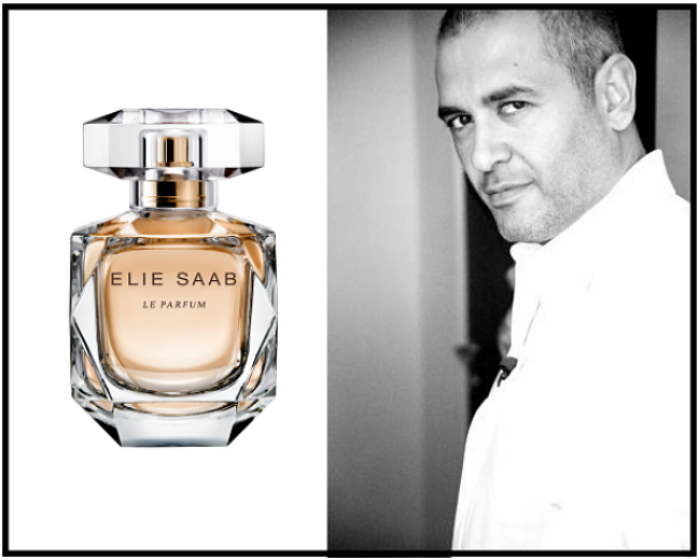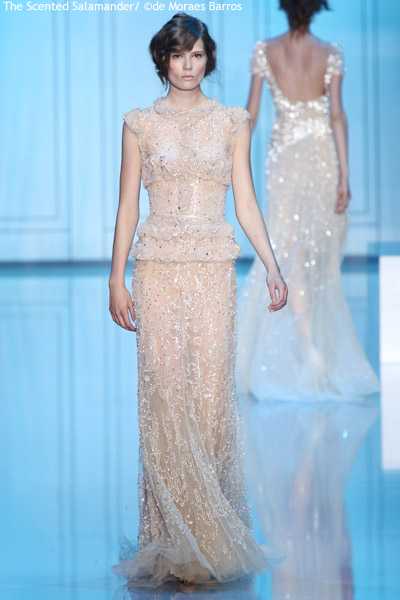Elie Saab Le Parfum (2011): Orange Blossom Goes Couture, Up to a Point {Fragrance Review}

Le Parfum by Elie Saab is the first fragrance by the Lebanese fashion designer who loves to design for the red carpet, to illustrate his glamorous style into an olfactory form. Saab readily acknowledges that while he knows what natural smells he prefers, he is more of a neophyte when it comes to fine fragrances...
The designer also comments that he finds the fragrance industry to be much more industrial in spirit than the fashion industry. Having said all that, Saab sees the addition of a fragrance to his portfolio as being essential for his couture house as well as being supportive of his future projects for developing a lifestyle extension of the brand.
 Fragrance Notes are: orange blossom, jasmine, cedarwood, patchouli, rose honey.
Fragrance Notes are: orange blossom, jasmine, cedarwood, patchouli, rose honey.
Scent-wise, Elie Saab Le Parfum appears to be mainly about the association of orange blossom with luminous aldehydes, which makes it feel like a couture version of the fresh, fruity-floral note.
Thinking about the trend for orange blossom perfumes that has been blossoming since last spring of 2011, this is precisely one of the orientations one sees in the recent offerings: a choice between either a more exhuberant, natural feel, and a more cinched, couture feel.
While Le Parfum by Elie Saab is without the shadow of a doubt a "couture" orange blossom perfume to the nose, it nevertheless plays a bit with the joyous quality of orange blossom.
Another aspect which was underlined by the nose who created the fragrance, Francis Kurkdjian, is the contrast of warmth and freshness which he said would be a perfect embodiment of Catherine the Duchess of Cambridge. Finally, while being presented as a woody-floral, it is not the most prominent impression left by the scent.
Aldehydes here give the Eau de Parfum a polished, sophisticated quality which makes sure to stress the fact that this is no country-girl, nor mommy-and-baby orange blossom scent. A touch of medicinal, brocaded oud adds a subliminal idea of hush-hush Oriental opulence. A bit of Calone makes it sheerer and double-lines the freshness of orange blossom in a man-made manner. A discreet almond-y nuance underlines the composition making it teeter on the edge of gourmand, but not quite tumble there yet; later on, the edible marzipan nuance becomes more accentuated. Citrus brings it projection and sparkle. The warm and also sublty Middle-Eastern feel of the fragrance seem to rest in part on an unreported note of oud with its slight band-aid nuance, which is quite muted here.
As the scent dries down, you come to think that it seems that the main envisioned task was to offer an impression of orange blossom translated into urbane, fashion-conscious language. The signature of the scent is classical, even a bit quiet and conservative. It riffs on the orange-blossom and tuberose genre although it is jasmine which is mentioned, not tuberose. It is a womanly perfume in style, rather than girly, yet the sexual indoles of the white floral notes are completely under control.
 There is nothing really surprising about the composition, except perhaps its lack of interest in pushing new frontiers, especially so perhaps for a debut fragrance. Especially so, moreover, since perfumer Francis Kurkdjian could have been more daring, if he wanted to. But this is the work of a professional perfumer more than that of a creative perfumer. The nose's olfactive blue print was reportedly chosen among dozens of others. He said that the brief from the designer was stated as "Get my style and get my spirit into a bottle." The result is a convincingly faithful translation of Elie Saab's couture code into perfume.
There is nothing really surprising about the composition, except perhaps its lack of interest in pushing new frontiers, especially so perhaps for a debut fragrance. Especially so, moreover, since perfumer Francis Kurkdjian could have been more daring, if he wanted to. But this is the work of a professional perfumer more than that of a creative perfumer. The nose's olfactive blue print was reportedly chosen among dozens of others. He said that the brief from the designer was stated as "Get my style and get my spirit into a bottle." The result is a convincingly faithful translation of Elie Saab's couture code into perfume.
The fashion designer likes to stress that his one interest in couture is to make women beautiful and that he values simplicity over everything else. He said,
"I don't like women who take risks. Because for me, the more important thing for a woman is that she respects her femininity and her image. To be a fashion victim for what? It's complicating life for nothing."*
He further elaborated,
"she wants to be beautiful. From my side, this is my obsession, always. I don't go far, I don't want to do stories. I want to do clothes flattering for a woman only. It's my target."

Le Parfum by Elie Saab was also based on childhood memories of the couturier, in particular his recollection of the fragrances of orange blossom and jasmine wafting around his house growing up in Lebanon. This may explain the understated gourmand touch which adds that touch of naïveté and back-to-basics explicitly appreciated by the designer. In this context, the almond lingers, attenuated, like a memory of a macaron. But without doubt, it is also a reference to the palette of Kurkdjian who has worked on both key orange blossom notes (Fleur du Mâle) and almond accords (Gaultier2) in the past.
Judging from some of the reactions on the France Sephora website where Le Parfum launched in July 2011 (international rollout will be in September 2011), the fragrance seems to be a hit with those who tried it.
It is an accessible orange blossom scent, with a measure of glamour thrown into the mix (the bottle inspired by a crystal paper-weight belonging to Saab is heavy and luxurious-feeling.) The flacon might have cost more than the juice itself. Designers who are not perfume literate at least have an eye due to their occupation and this shows here with the emphasis put on the visual aspect of the fragrance. Saab said of the bottle signed by Sylvie de France,
"I wanted something simple. Straight lines, the rigor of a cube, and the sensation of an object made to be held in the hand, but with the density of beautiful objects. "And as always, light as the overarching theme. For me, light is eternal strength."
Those who are looking for an understated, uncomplicated, fairly elegant scent and who moreover enjoy orange blossom can give it a whirl. Le Parfum does not pretend to offer originality, nor shock value. Elie Saab mentioned Lady Gaga as his style nemesis, quite rightly so; her fragrance will no doubt be the polar opposite of his.
But this is where the designer perfume thriving on classicism encounters its limits. Indeed, a classically styled perfume needs more than others to impress with its materials. Budgetary constraints weigh heavier on the category and so when classical ingredients, read: rose, jasmine, neroli etc, are rationed creative quirks can be the saving grace of such perfumes. Thinking of, say, Rush by Gucci, I do not find in Le Parfum, the kind of mind-teasing quality that can tell you this is a perfume with ideas.

Its main idea being to be an ode to the beauty of women, it would normally need to rely on beautiful materials or the sensation of being breathtakingly beautiful, which is not really the case here. This is no Joy or 1000 de Patou, nor Beautiful by Estée Lauder. The fragrance does not leave a lasting sillage either, which is a sort of inescapable contradiction for a scent destined to flatter the eternal beauty of women and which is moreover one inspired by memories.
On the other hand, does it fulfill the brief? In many ways, yes, - it took them 279 tries to bring the composition to fruition - except in that it could have been easily made to feel more luxurious on the olfactory plane.
It seems that the uncomplicated quiet remembrance of childhood memories might have taken over the fashion couture signature. Maybe there was a better balance to be achieved here.









